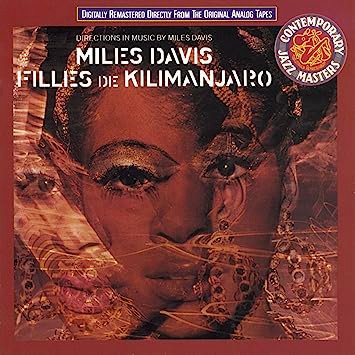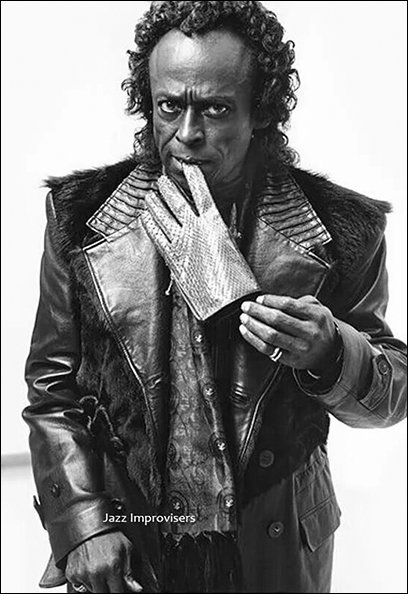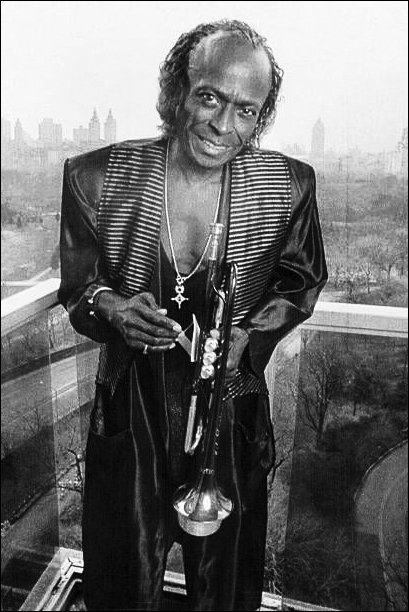Jazz post-bop/jazz fusión: «Frelon Brun (Brown Hornet)» y «Tout de Suite (Right Away)» [ESP/ENG]
(Edited)
Frelon Brun (Brown Hornet)
Wayne Shorter (saxo tenor), Miles Davis (trompeta), Chick Corea (RMI Electra-piano), Dave Holland (contrabajo) y Tony Williams (batería). Extraído del álbum Filles de Kilimanjaro (1969) de Miles Davis.
Este es el sexto y último álbum que grabó Miles Davis con su segundo gran quinteto, puesto que Chick Corea y Dave Holland reemplazaron a Herbie Hancock y Ron Carter en dos de los temas. A diferencia de Nefertiti, donde el compositor principal fue Shorter, en este álbum todos los temas están escritos por Davis. El arreglista Gil Evans, con quien había colaborado en tres importantes trabajos, ayudó a componer, preparar y producir el álbum, que puede considerarse como una obra de transición entre las grabaciones acústicas de Davis con su segundo gran quinteto y su período eléctrico posterior. Está impregnado de la abstracción apasionante de los años sesenta, pero añadiendo tonalidades del blues, texturas electrónicas y ritmos bailables del jazz fusión posterior. Es el comienzo de una nueva etapa para Davis en la que empieza a esbozar el jazz fusión. Era un músico innovador que se exigía tanto a sí mismo como a sus músicos crecer continuamente.
This is the sixth and last album recorded by Miles Davis with his Second Great Quintet, since Chick Corea and Dave Holland replaced Herbie Hancock and Ron Carter on two of the themes. Unlike Nefertiti, where the main composer was Shorter, all the tracks on this album are written by Davis. Arranger Gil Evans, with whom he had collaborated on three important works, helped compose, prepare and produce the album, which can be considered a transitional album between Davis’ acoustic recordings with his Second Great Quintet and his later electric period. It’s permeated with the exciting abstraction of the 1960s, but adding blues tones, electronic textures and danceable rhythms of later jazz fusion. It’s the beginning of a new stage for Davis in which he starts to outline jazz fusion. He was an innovative musician who required both himself and his musicians to grow continuously.

En este álbum es posible escuchar cómo el segundo gran quinteto rompe incluso con el post-bop que ellos mismos habían promovido para convertirlo en algo nuevo. Davis deseaba volver a tocar algo terrenal y bluesy, y buscar una nueva esfera musical. En el álbum podemos encontrar una música sin grandes pretensiones, con impulso, ritmos ligeramente funky y adornada con florituras peculiares y coloridas, aunque está más enfocada que en Miles in the Sky. Está en transición entre Nefertiti, el máximo exponente en el exquisito y refinado post-bop, y In a Silent Way, el primer logro coherente de jazz fusión, aunque todavía estuviera en fase de gestación. Pero esto no es un inconveniente, este término medio entre el post-bop y el jazz fusión de finales de los años sesenta es gratificante por sí mismo, ya que es posible escuchar a grandes músicos encontrar los fundamentos de un nuevo estilo de jazz.
In this album it’s possible to hear how the Second Great Quintet break even with the post-bop that they themselves had advocated to turn it into something new. Davis wanted to play something earthy and bluesy again, and look for a new musical field. In the album we can find a music without great pretensions, with impulse, slightly funky rhythms and adorned with unusual and colorful flourishes, although it’s more focused than Miles in the Sky. It’s in transition between Nefertiti, the highest exponent of the exquisite and refined post-bop, and In a Silent Way, the first consistent achievement of jazz fusion, although still in the gestation phase. But this is not an inconvenience, this middle ground between post-bop and jazz fusion of the late 1960s is gratifying in itself, since it’s possible to listen to great musicians find the foundations of a new style of jazz.

La introducción la hace Corea con el RMI Electra-piano tocando varias veces dos notas muy graves acompañado por Williams, y luego entran Shorter, Davis y Holland para exponer el tema. A continuación Corea vuelve a tocar las dos notas, después otras dos y luego se pone a arrojar acordes disonantes para dar paso a Davis. Este hace un solo sólido y consistente mientras Corea sigue tocando las notas graves y los acordes disonantes una y otra vez, y Williams se desboca. Luego llega Shorter con una línea melódica decidida y bien elaborada con Corea tocando ahora solo acordes y Williams cometiendo todo tipo de excesos. Le sigue Corea con un discurso excéntrico que parece procedente de otro planeta hasta que vuelven Shorter y Davis para reexponer el tema.
The introduction is made by Corea with the RMI Electra-piano playing several times two very low notes accompanied by Williams, and then Shorter, Davis and Holland enter to expose the theme. Afterwards, Corea plays the two notes again, then two more and then begins to throw dissonant chords to give way to Davis. He makes a solid and consistent solo while Corea continues to accompany with the low notes and dissonant chords over and over again, and Williams goes wild. Next Shorter arrives with a determined and well-crafted melodic line with Corea playing now only chords and Williams committing all kinds of excesses. Corea follows with an eccentric improvisation that seems to come from another planet until Shorter and Davis return to re-expose the theme.

Translated with the help of DeepL

Tout de Suite (Right Away)
Wayne Shorter (saxo tenor), Miles Davis (trompeta), Herbie Hancock (piano eléctrico Fender Rhodes), Ron Carter (bajo eléctrico) y Tony Williams (batería). Extraído del álbum Filles de Kilimanjaro (1969) de Miles Davis.
La sección rítmica hace una larga, suave y bluesy introducción, y a continuación entran Shorter y Davis para exponer el tema al unísono a tiempo medio lento. Entonces se queda sola la sección rítmica durante un rato y luego entra Davis para hacer su solo. Toca frases cortas con autoridad y confianza mientras Hancock le acompaña con acordes entrecortados. Le sigue Shorter también con una línea melódica intermitente y haciendo filigranas de vez en cuando. Ahora le toca el turno a Hancock, que presenta un discurso dinámico e inspirado. Para terminar, el grupo toca un tema distinto y más largo y la sección rítmica continúa sola hasta que finaliza.
The rhythm section makes a long, smooth and bluesy introduction, and then Shorter and Davis come in to expose the theme in unison at medium-slow tempo. Then the rhythm section is left alone for a while and next Davis enters to make his solo. He plays short phrases with authority and confidence while Hancock accompanies him with broken chords. He is followed by Shorter also with an intermittent melodic line and makes filigrees once in a while. Now it’s Hancock’s turn, who delivers a dynamic and inspired speech. To finish, the group plays a different and longer theme and the rhythm section stays by themselves until they end.

0
0
0.000


¡Enhorabuena!
✅ Has hecho un buen trabajo, por lo cual tu publicación ha sido valorada y ha recibido el apoyo de parte de CHESS BROTHERS ♔ 💪
♟ Te invitamos a usar nuestra etiqueta #chessbrothers y a que aprendas más sobre nosotros.
♟♟ También puedes contactarnos en nuestro servidor de Discord y promocionar allí tus publicaciones.
♟♟♟ Considera unirte a nuestro trail de curación para que trabajemos en equipo y recibas recompensas automáticamente.
♞♟ Echa un vistazo a nuestra cuenta @chessbrotherspro para que te informes sobre el proceso de curación llevado a diario por nuestro equipo.
🏅 Si quieres obtener ganancias con tu delegacion de HP y apoyar a nuestro proyecto, te invitamos a unirte al plan Master Investor. Aquí puedes aprender cómo hacerlo.
Cordialmente
El equipo de CHESS BROTHERS
Congratulations @fjcalduch! You have completed the following achievement on the Hive blockchain And have been rewarded with New badge(s)
Your next target is to reach 1800 posts.
Your next target is to reach 2500 comments.
Your next target is to reach 2500 replies.
You can view your badges on your board and compare yourself to others in the Ranking
If you no longer want to receive notifications, reply to this comment with the word
STOPCheck out our last posts: